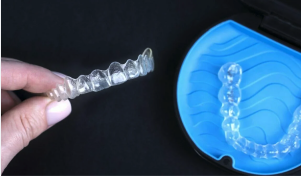What is composite bonding? Composite bonding is a cosmetic dental procedure to restore and enhance teeth that are discoloured, chipped, cracked or spaced out. It’s becoming a very popular procedure thanks to its long-term effectiveness and affordability. In this blog post, we will explain what composite bonding is, how it differs from other cosmetic dental procedures, and who would benefit the most from this procedure.
During a composite bonding procedure, a tooth-coloured composite resin material is applied to the surface of the teeth using a special adhesive, which is then hardened with a curing light. The resin material is then shaped and polished to match the natural shape of the teeth.
The procedure is non-invasive and can be carried out in a single visit. It does not require the removal of any tooth enamel, making it a less invasive alternative to veneers. Composite bonding is a versatile procedure which can be used for a wide range of cosmetic dental issues.
What Are The Benefits Of Composite Bonding Compared To Other Cosmetic Dental Procedures?
Composite bonding offers several benefits over other cosmetic dental procedures, including:
- Affordability – Composite bonding is a more affordable alternative to porcelain veneers, which can cost up to ten times more.
- Non-invasive – Unlike veneers, composite bonding does not require the removal of tooth enamel, making it a less invasive procedure.
- Versatility – Composite bonding can address a wide range of cosmetic dental issues, including discoloured, chipped, cracked or overly spaced teeth.
- Natural-looking – The composite resin material used in composite bonding is tooth-coloured, which means it blends seamlessly with your other teeth, creating a natural-looking result.
Who Would Benefit The Most From Composite Bonding?
Do you want to enhance the appearance of your teeth? Composite bonding could be for you. Whether you are concerned about discolouration, damage to a tooth, or overly spaced or crossed-over teeth, this minimally invasive procedure resurfaces your tooth and shapes it to improve its appearance. Here are some of the reasons you might benefit from composite bonding:
Affordable and minimally invasive
One of the significant benefits of composite bonding is that it is a conservative and affordable alternative to other cosmetic dental procedures such as porcelain veneers, dental crowns or orthodontic work. It is a quick and easy procedure that can be completed in one appointment, and the results are often visible immediately.
Boosts your confidence
Having a beautiful smile can make a huge difference in how you feel about yourself and how you interact with others. Whether it’s a job interview or a first date, or a special occasion like a wedding or family event – composite bonding can help you feel more comfortable and confident in all areas of your life.
Lasting effects
The expected results of composite bonding vary depending on your specific needs and the extent of the dental work required. But in general, composite bonding can last up to five years with proper care and maintenance. Proper care and maintenance include regular brushing and flossing, avoiding hard or sticky foods, and visiting the dentist for regular check-ups and cleanings.
It’s not for everyone
Composite bonding is not suitable for everyone. People with severe tooth decay, gum disease, or severely damaged teeth may require more extensive dental work before composite bonding can be performed. Also, if you grind your teeth, you may not be a good candidate for composite bonding as the composite resin material can be easily damaged.
How Much Does Composite Bonding Cost?
The cost of composite bonding can vary widely depending on several factors, including the amount of work needed, the number of teeth involved, and the location of the dental practice.
At Ollie & Darsh, for example, the cost of composite bonding starts at £335 per tooth. The final cost can be significantly higher if multiple teeth are involved or if additional procedures are required.
Composite bonding is generally more affordable than porcelain veneers, which can cost up to ten times more than composite bonding. Porcelain veneers are thin shells made of porcelain that are custom-made to fit over the front surface of the teeth to improve their appearance. While veneers can provide a more durable and long-lasting solution than composite bonding, they are also significantly more expensive.
You also need to remember that composite bonding is a cosmetic dental procedure and is not typically covered by dental insurance. Some dental practices may offer financing options, or payment plans to make the procedure more affordable for patients – at Ollie & Darsh, we offer 0% finance on our treatments. It is always a good idea to discuss the cost and payment options with your dentist before undergoing any dental procedure.
What Are Some Common Misconceptions About Composite Bonding?
There are several myths and misconceptions about composite bonding, including:
- Composite bonding is painful – this is incorrect. It’s a non-invasive procedure that does not require the use of any anaesthetic. You may experience mild discomfort or sensitivity during the procedure, but this is usually temporary and can be managed with over-the-counter pain relievers.
- Composite bonding is not as durable as porcelain veneers – this is true, up to a point. While composite bonding may not be as durable as porcelain veneers, it can last up to five years with proper care and maintenance. Additionally, composite bonding can be repaired or replaced if damaged or discoloured.
- Composite bonding looks fake or unnatural – this is incorrect. Composite bonding uses a tooth-coloured resin material that blends seamlessly with the natural teeth, creating a natural-looking result. With the proper technique and materials, composite bonding can be virtually indistinguishable from natural teeth.
- Composite bonding is only for cosmetic purposes – this is incorrect. While composite bonding is usually a cosmetic dental procedure, it can also be used to repair minor dental issues, such as chips or cracks.
Ask Ollie & Darsh
So, now you know that composite bonding is an effective and affordable cosmetic dental procedure that can be used to restore and enhance teeth that are discoloured, chipped, cracked or spaced out. It is an excellent option for anyone who wants to improve their smile without undergoing a more invasive – and expensive – dental procedure.
If you are interested in composite bonding, please get in touch with the highly experienced and helpful team at Ollie & Darsh on our contact us page, or book online to schedule an appointment with our dental professionals.

